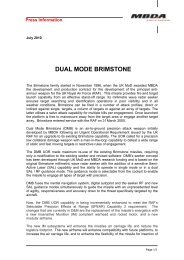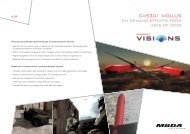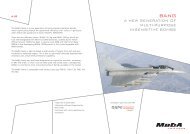TAURUS KEPD 350 - MBDA
TAURUS KEPD 350 - MBDA
TAURUS KEPD 350 - MBDA
You also want an ePaper? Increase the reach of your titles
YUMPU automatically turns print PDFs into web optimized ePapers that Google loves.
Press Information<br />
June 2011<br />
The <strong>TAURUS</strong> <strong>KEPD</strong> <strong>350</strong> weapon system is one of the most modern long range standoff<br />
guided missile systems available, providing the <strong>TAURUS</strong> User Community with an<br />
exceptional stand-off precision strike capability.<br />
The <strong>TAURUS</strong> <strong>KEPD</strong> <strong>350</strong> missile is a highly advanced modular all-weather stand-off<br />
weapon and is extremely effective against hardened high value point targets and can<br />
also be used equally effectively against area targets.<br />
The design of the <strong>TAURUS</strong> <strong>KEPD</strong> <strong>350</strong> missile will provide the user with an enhanced<br />
strike capability against a broad target spectrum, ranging from bunkers and bridges to<br />
runways and ships in port.<br />
The <strong>TAURUS</strong> <strong>KEPD</strong> <strong>350</strong> has been designed to penetrate and take out dense airdefences<br />
and neutralise high-value stationary and quasi-stationary targets.<br />
The accuracy in combination with its exceptional stand-off capability ensures a highly<br />
effective weapon delivery while minimising the threat to launch aircraft and crew.<br />
The weapon system design was carried out with a strong involvement of end-users<br />
leading to the achievement of a number of key parameters that contribute to the high<br />
mission success rate, starting with the high accuracy by which the missile delivers the<br />
warhead into the target.<br />
The <strong>KEPD</strong> <strong>350</strong> missile uses “Tri-Tec” navigation, to ensure highly robust navigation<br />
system with an inertial measurement unit as its core resulting in an exact delivery to the<br />
target. The “Tri-Tec” array of sensors means that the <strong>TAURUS</strong> <strong>KEPD</strong> <strong>350</strong> weapon<br />
system can utilize different combinations the following sensor inputs (user- or<br />
automatically selected depending on scenario):<br />
• GPS data,<br />
• Terrain profile and<br />
• Infrared image information<br />
<strong>TAURUS</strong> <strong>KEPD</strong> <strong>350</strong><br />
The accuracy of the missile’s guidance system on its extremely low-level (“nap-of-theearth”)<br />
flight requires a highly agile and manoeuvrable missile. As a result, the<br />
<strong>TAURUS</strong> <strong>KEPD</strong> <strong>350</strong> missile was given the most powerful turbo-fan engine of its class,<br />
thus allowing for high cruise speed at low level, which combined with the guidance<br />
system, allows for quick and agile manoeuvres ensuring that the missile stays precisely<br />
on the planned flight path.<br />
The <strong>TAURUS</strong> <strong>KEPD</strong> <strong>350</strong> missile structure has been designed around the highly<br />
efficient dual stage warhead (MEPHISTO), providing a superior penetration capability<br />
compared with other stand-off missile systems.<br />
The MEPHISTO warhead contains an intelligent fuze, which is the only one of its kind.<br />
Page 1/3
The programmable fuze allows the detonation of the penetrator to be pre-selected for<br />
any floor, deep within the target structure. This is achieved through layer counting and<br />
void sensing technology.<br />
The survivability of the <strong>TAURUS</strong> <strong>KEPD</strong> <strong>350</strong> missile is based on low observability (LO)<br />
and terrain masking; therefore, the <strong>TAURUS</strong> <strong>KEPD</strong> <strong>350</strong> missile offers excellent<br />
manoeuvrability, enabling terrain following at very low altitudes.<br />
The <strong>TAURUS</strong> <strong>KEPD</strong> <strong>350</strong> Mission Planning System optimizes the flight path taking the<br />
entire threat scenario for a theatre into account.<br />
The <strong>TAURUS</strong> <strong>KEPD</strong> <strong>350</strong> Mission Planning System will attempt to avoid the line-ofsight<br />
of all radars; however, should this prove impossible due to the density of airdefence<br />
systems, the LO-features, both missile integral and mission planning (low-level<br />
flight) will be utilized.<br />
The <strong>TAURUS</strong> <strong>KEPD</strong> <strong>350</strong> Mission Planning System will plan the missile trajectory in<br />
such a way that the exposure to radars will be minimized in such a way that the missile<br />
will present the lowest possible Radar Cross Section to the threat radars.<br />
The <strong>TAURUS</strong> <strong>KEPD</strong> <strong>350</strong> missile architecture was conceived to reach a modular<br />
design, allowing for easy realisation / incorporation of growth potentials to the missile<br />
as well as simplifying maintenance efforts over the lifetime of the system, resulting in a<br />
Low Life Cycle cost.<br />
Example Key features of the <strong>TAURUS</strong> <strong>KEPD</strong> <strong>350</strong> weapon system are:<br />
• range in excess of 500 km<br />
• Multi-target capability covering a wide variety of global scenarios.<br />
• High survivability, excellent detection avoidance through low observability (LO)<br />
and terrain masking resulting in high mission success rates.<br />
• Adaptability to different targets and operational scenarios.<br />
• Highly robust navigation system with proven accuracy also when GPS is<br />
unavailable.<br />
• Unique lethality against hard and deeply buried targets (HDBT)<br />
• Keeping collateral damage low<br />
• High reliability, modular design leading to low Life Cycle Cost.<br />
Programme status<br />
The <strong>TAURUS</strong> <strong>KEPD</strong> <strong>350</strong> is deployed on the German Luftwaffe’s Tornado IDS.<br />
<strong>TAURUS</strong> <strong>KEPD</strong> <strong>350</strong> is deployed on the EF-18 Hornet aircraft.<br />
The <strong>TAURUS</strong> <strong>KEPD</strong> <strong>350</strong> is selected as the stand-off weapon for the NATO Reaction<br />
Forces.<br />
Spain and Germany are planning the integration of the <strong>TAURUS</strong> <strong>KEPD</strong> <strong>350</strong> for their<br />
respective Eurofighter-fleets.<br />
The <strong>TAURUS</strong> <strong>KEPD</strong> <strong>350</strong> missile can be integrated onto a variety of different carriers,<br />
which has been shown on several occasions, including captive flights performed on<br />
SAAB AB’s JAS 39 Gripen aircraft, confirming very good flight characteristics whilst<br />
Page 2/3
carrying the <strong>TAURUS</strong> weapons.<br />
<strong>TAURUS</strong> Systems GmbH is currently in discussions with a number of potential<br />
customer nations.<br />
History<br />
The <strong>TAURUS</strong> <strong>KEPD</strong> <strong>350</strong> weapon system programme commenced in 1998 by pooling<br />
the industrial capabilities in the field of precision stand-off guided missile systems of<br />
<strong>MBDA</strong> Deutschland (LFK-Lenkflugkörpersysteme GmbH) with those of Saab Dynamics<br />
AB. A joint venture company, <strong>TAURUS</strong> Systems GmbH (TSG), was established in<br />
Schrobenhausen, Germany.<br />
<strong>TAURUS</strong> Systems GmbH is responsibility for the development, production, marketing<br />
and logistics support of the <strong>TAURUS</strong> <strong>KEPD</strong> <strong>350</strong> weapon system.<br />
Internet : www.mbda-systems.com<br />
www.taurus-systems.de<br />
Page 3/3

















